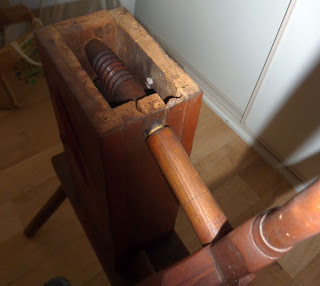Sue explained that it was part of a larger unit known as a Spinners Weasle and lends in some way to the old nursery rhyme "Pop Goes The Weasle". I know 2 versions of that nursery rhyme (well ok knew).
- Half a pound of tuppenny rice,
- Half a pound of treacle.
- That’s the way the money goes,
- Pop! goes the weasel.[1]
Often a second verse is added:
- Every night when I go out,
- The monkey’s on the table,
- Take a stick and knock it off,
- Pop! goes the weasel.[1]
And:
- Up and down the city road
- In and out the Eagle. (I knew this bit as people)
- That’s the way the money goes,
- Pop! goes the weasel.
So how does the Spinning Weasle relate to the rhyme?
Its all in the mechanics of it. As the wool is wound round the arms the main shaft which has a worm gear cut into it turns the differential gear which on the outside of the box is an indicator. This shows the relation to number of turns and the length of yarn for each revolution of the counter. The one I have repaired is 80 yards per revolution of the counter.
Internally a pin on the gear cog comes into contact with an elongated stick which is flicked each time it passes, this slaps a block making a Popping sound. Unfortunately the mechanism for this one I repaired was removed some time ago and I have not been asked to repair or rebuild it.
Here is a fine example of how it works.
Its all in the mechanics of it. As the wool is wound round the arms the main shaft which has a worm gear cut into it turns the differential gear which on the outside of the box is an indicator. This shows the relation to number of turns and the length of yarn for each revolution of the counter. The one I have repaired is 80 yards per revolution of the counter.
Internally a pin on the gear cog comes into contact with an elongated stick which is flicked each time it passes, this slaps a block making a Popping sound. Unfortunately the mechanism for this one I repaired was removed some time ago and I have not been asked to repair or rebuild it.
Here is a fine example of how it works.
Below The one to repair prior.
The task was to repair the main shaft!!
The arms and shaft were all that Sue had brought home, I realised at first sight its approximate age 100 years+. The on closer inspection I'd need the rest of the unit as the repair job done previously was so far out of alignment if I'd just done the repair and sent it back it would not work. So we drove out to the lovely Linda's place and picked up the main pedestal/box section. Glad we did.


 The internal workings and badly damaged front yoke where the shaft had to rotate. I also noticed the rear shaft support hole had been flogged out to an oval shape. Right is the indicator.
The internal workings and badly damaged front yoke where the shaft had to rotate. I also noticed the rear shaft support hole had been flogged out to an oval shape. Right is the indicator. The true state of the main shaft showing where the copper tube repair was located right on the yoke.
 On opening the box we discovered square nails, blacksmith made so 100 years plus was minimal age.
On opening the box we discovered square nails, blacksmith made so 100 years plus was minimal age.
discovery of a broken tooth to repair as well it doesn't look to long ago since it was broken.

Assessment over now onto the repair. Main shaft first. I drilled each side of the shaft in centre as best I could 7mm and inserted a copper coated 7mm steel rod 100mm long. No glue as it was a push fit and should for years hold. I left the copper furel of the previous repair in place as to make the union marry and be of strength using timber fruitless and waste of time.


 A test run proved the rear support hole for the shaft would need a fix.
A test run proved the rear support hole for the shaft would need a fix.But firstly the broken tooth. I took this idea from seeing an engineered steel gear tooth replaced except it was brazed in, this was glued in. I cut along the path of both teeth either side to form a deep V (the photo of it all cleaned up didn't turn out well enough).
A scarp piece of English Oak held in place overnight by an elastic band.

Then to shape the tooth using Coping saw and Microplane and fine file to finish.


The rear mounting hole for the shaft filled with another off cut of English Oak push fit again. Then to use the old brace and bit to drill it again.
Completed and reassembled.
Lunch time a decent serve of Fish n Chips between us.
















No comments:
Post a Comment
Your comments are welcome please forgive us if not replied to immediately.